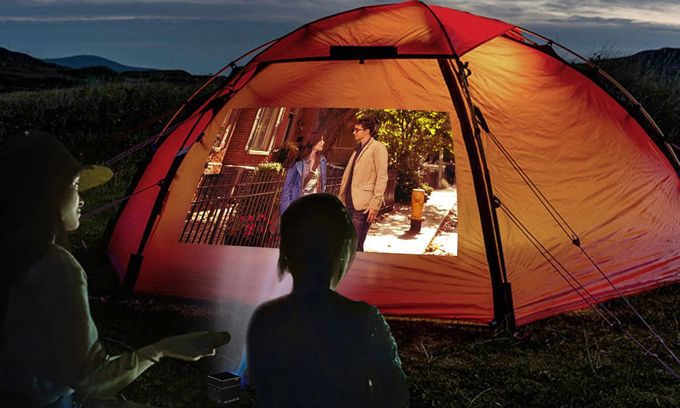Improvement of lasers and LEDs has allowed engineers to use them asLaser LEDs has allowed engineers to use them as solid-state light sources for projectors. Powerful lamp-based projectors provide high brightness, but require a powerful fan and a large internal volume to cool the lamp. In addition, the fan operation is accompanied by a fairly high noise level up to 70 dB and even higher. The brightness of LED projectors is much lower, but they do not heat up and do not require cooling. This allowed companies to develop miniature projectors. As a result, the first ultra-portable pocket projectors hit the market.
Consumers were enthusiastic about the new product. Of course, the companies responded adequately to the high demand by actively developing new mini projectors. Today the list of leaders includes AAXA, Miroir, Optoma, Anker, APEMAN.
But, of course, this list is far from complete. For example, RIF6 introduced only one, but unprecedentedly popular RIF6 CUBE mini projector, with a size and weight of only 2 inches and 0.36 lbs (136 g).
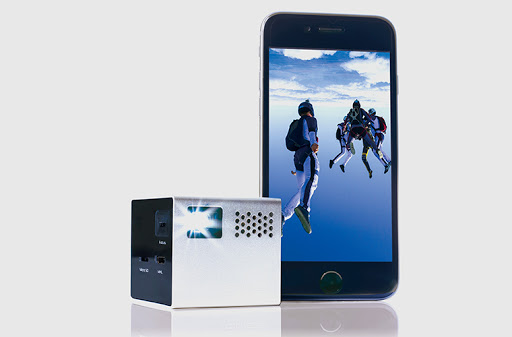
As a result, the market today offers an abundant range of excellent ultra-portable projectors including, for example, AAXA P7, LG PH30N, etc.
Almost all modern mini-projectors use DLP (Digital Light Processing) chip from the American Texas Instruments company. Of course, this technology has some key features that affect the specs of portable models.
Specs
1. Dimensions and weight
For marketing reasons, some companies sometimes position models weighing a few pounds or more as mini. This was hardly correct in relation to consumers, because most of these projectors are unlikely to fit even in a sufficiently large pocket. But, of course, this criterion depends on the individual perception.
Some modern models have a built-in battery, which adds weight, but is very convenient in many cases. They usually provide several hours of battery life.
2. Connectivity is very important for accessing content. Most modern models connect to a smartphone and support screen-mirroring options. As known, wireless Screen Mirroring technology provides transferring content from Android, Windows or Apple devices to a TV or projector using the Miracast protocol.
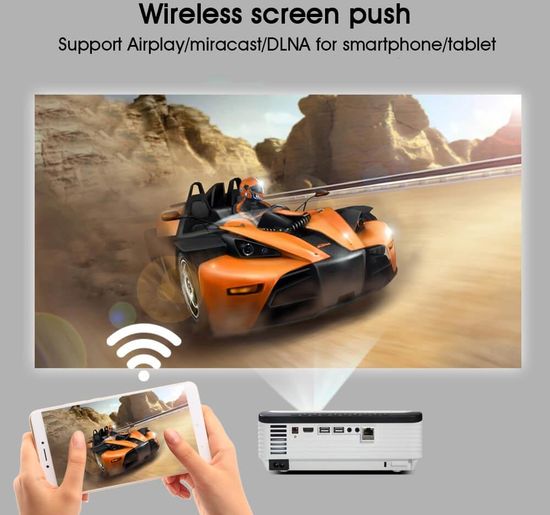
3.Brightness provides contrast and clarity to bright image areas. Accordingly, the low brightness model will project an image that is too dim.
Lamp-based projectors often provide several thousand ANSI Lm. Unfortunately, lamp cooling requires a powerful fan and a large internal volume, which increases the size. In addition, the operation of a powerful fan is accompanied by a fairly high noise level up to 70 dB and even higher. Moreover, the lamp life rarely exceeds 5,000-6,000 hours.
Portable solid-state projectors do not have these cons. For example, LEDs life ranges from 20,000 to 30,000 hours. Unfortunately, their brightness is significantly lower. Of course, high-power lasers do not have this limitation, but their cost is very high.
4. Many models have built-in mid-range speakers and Bluetooth or AV connector for external speakers.
5. Contrast characterizes the ratio of white to black, and affects color accuracy and image clarity in bright areas of the frame. For marketing purposes, manufacturers often specify dynamic contrast that is fundamentally different from native contrast.
Native contrast vs dynamic iris
Contrast in the specs of modern models is indicated as Contrast or ANSI contrast. Contrast represents the basic on / off contrast between the lightest white and darkest blacks that the projector can produce. ANSI contrast is calculated using a “checkerboard”, and characterizes the relative brightness of blacks and whites. Of course, the basic contrast is always much higher because takes into account the brightest whites when the aperture is open and the blackest when the aperture is closed. But ANSI contrast more accurately characterizes the projector capabilities.
Dynamic iris is an additional mechanical device between the light source and the lens to adjust the light output. Modern dynamic iris significantly improves basic contrast. As a result, dark scenes are perceived darker and bright scenes – brighter.
Of course, companies are constantly improving Dynamic iris. For example, one of the industry leaders BenQ has developed and uses Dual Iris Technology.
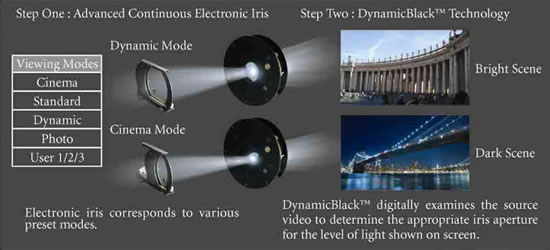
Advanced continuous electronic iris with different preset modes (Cinema, Dynamic, Standard and Photo) widens and narrows, letting out light depending on the selected contrast range.
DynamicBlack provides a second level of Iris control, changing contrast depending content. Algorithm analyzes the source video, calculates the optimal iris aperture for the light level in a scene and adjusts the iris accordingly.
In fact, the increasing efficiency of modern smart dynamic iris algorithms is gradually diminishing the importance of traditional contrast.
LED Lm vs ANSI Lm
Today some companies indicate the brightness of their LED projectors as LED Lm. This situation arose due to a discussion between experts about the influence of Helmholtz – Kohlrausch effect on perceived brightness.
It refers to an entoptic phenomenons. As known, source of entoptical (from Greek ἐντός “within” and ὀπτικός “visual”) visual effects is within the eye itself and determines individual perception.
Ophthalmologists today identify several of the most common entoptical effects.
The “Muscae volitantes” effect consists in the slow drift of droplets of various shapes, sizes and transparency, which are especially noticeable against a bright, but expressionless background, for example, in the sky.

A “blue field” appears as tiny bright dots that move rapidly along wavy lines in the visual field.
“Haidinger’s brush” is due to the predominant absorption of blue polarized light.
“Purkinya images” are reflections from the anterior and posterior surfaces of the cornea.
The “Purkinya tree” represents the perception of the retinal blood vessels in one’s own eye.
The Helmholtz – Kohlrausch effect affects visual perception when the intense saturation of spectral hue is perceived as part of the color’s luminance.
As known, LEDs provide significantly higher colors brightness. Therefore, the perceived brightness of image from LED projector is significantly higher compared to lamp projectors with similar brightness in ANSI Lm. Comparison photos from ViewSonic perfectly illustrate this effect.
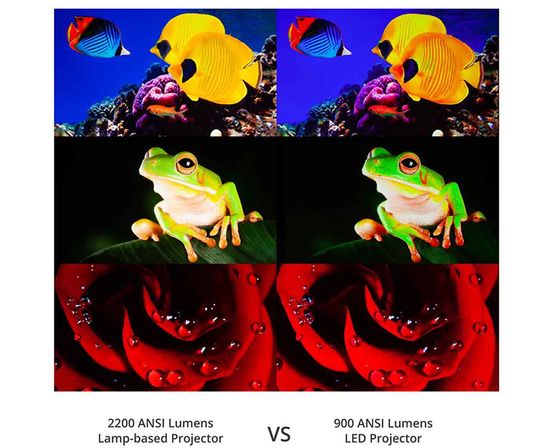
Of course, LED projector manufacturers are trying to exploit this factor for marketing purposes. Therefore, observing technological correctness, some companies in recent years indicate the brightness of their models as LED Lm. Of course, this aspect is important when evaluating the real projector brightness. Unfortunately, without knowing these nuances, most consumers perceive it as a typographical or technical error.
Conclusion
Choosing the optimal ultra-portable projector depends largely on several factors:
– compliance of the company and consumer perceptions of diminutiveness. Many “mini projectors” require a carrying bag;
– effective dynamic iris in models from well-known brands often provides excellent results even with relatively low basic contrast;
– the estimation of the brightness of ultra-compact LED projectors is incorrect in comparison with the brightness of lamp projectors due to the Helmholtz – Kohlrausch effect. In fact, the increased perception of the image brightness provides excellent quality on a large enough screen even at several hundred ANSI Lm;
– Wireless Screen Mirroring technology with Miracast protocol support radically expands the range of available content for projector.
This video offers projector contrast ratio comparison at theater lighting.
